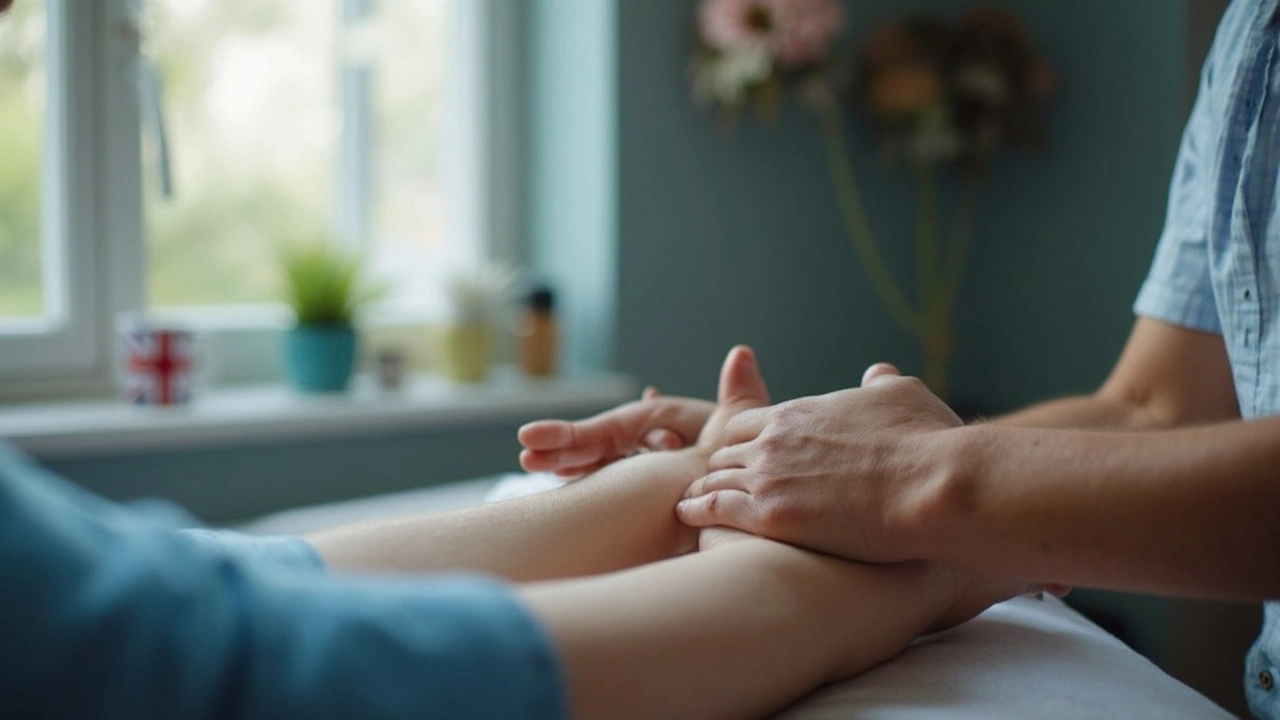Imagine having pain that just won't budge, whether it's in your back, your shoulders, or all the way down your legs. Not the sharp, "I just twisted my ankle on a run" kind, but the dull, nagging ache that builds up as the days stretch on. This story is way too common. Long hours hunched over a desk, dragging shopping bags around the city, or even scrolling endlessly on your phone—all these daily habits dig into your muscles and make life just a little more uncomfortable. Maybe you’ve already tried foam rollers, flaming-hot showers, wild stretches, or the full arsenal of pain relief gadgets. Yet, those persistent knots always seem to return. Here’s the surprising bit: the source of that stubborn pain might actually be the thin, clingy layer of connective tissue wrapping around your muscles—your fascia. Welcome to the real deal behind myofascial release therapy.
How Fascia Affects Your Everyday Pain and Movement
Most people barely give their fascia a thought—until it becomes a problem. This connective tissue web runs head to toe, wrapping everything from tiny muscles in your hands to giant slabs in your thighs. The thing is, fascia isn’t just hanging out under your skin; it plays bodyguard, shock absorber, and communication highway for your muscles. If you picture it sort of like plastic wrap for your muscles, you’re not far off.
What throws a wrench into the works is how easily fascia tightens up when you’re stressed, dehydrated, or following the "same routine, different day" script. Let’s say you play tennis on weekends. Every powerful backhand makes your dominant arm work hard, which keeps hammering the same stretch of fascia. The more your routines repeat, the more your fascia adapts by getting stiffer. Eventually, it loses its springy resilience. Studies have shown that poor hydration is a huge culprit behind stiff fascia—one famous 2018 paper in the Journal of Bodywork & Movement Therapies found that fascia loses flexibility fast when you’re even a bit dehydrated.
Ever wonder why muscle knots feel lumpy or why stretching sometimes feels useless? When the fascia locks down, it squishes nerves and blood vessels underneath, messing with both sensation and nutrition for your muscles. It’s not just a pain thing; it can change how you walk, breathe, and even the way you hold your phone. If you saw MRI scans of people with chronic pain, you’d notice "adhesions"—thickened patches of fascia stubbornly clinging where they shouldn’t.
Don’t believe fascia can really ruin your day? Check research on plantar fasciitis or frozen shoulder—both conditions share the same story: once the fascia thickens and tightens, pain can stick around for months, even years. Plus, the "pain map" isn’t always logical. Stiffness in your calf fascia could start aches that creep up to your lower back. Everything’s connected. This is why addressing the fascia is critical for long-term relief, not just masking the distraction of pain with quick fixes.
What Is Myofascial Release Therapy, Anyway?
Myofascial release therapy is kind of like a deep tissue massage with laser focus on the fascia instead of just the muscles. So what makes it special? Picture this: slow, deliberate pressure combined with gentle stretches—think of someone gliding their hands, a lacrosse ball, or even an elbow into those stiff, ropey spots and holding just long enough to "melt" the tightness away. The objective is simple but not always easy: restore the natural glide and resilience of the fascial web.
Most myofascial therapists don’t just poke around until you wince; they're looking for "trigger points" (feel-for-nodules type of things that stubbornly hold tension) and tracing out any fascial "lines" that connect pain spots. Therapists often use their knuckles, fingertips, forearms, or special tools to stretch and gently shear the fascia. Unlike a classic Swedish massage, myofascial release doesn’t chase after quick relaxation. There's often a bit of discomfort, the kind that feels like a good stretch—not bad pain. They might dig in for two minutes or more. Research from the International Journal of Therapeutic Massage and Bodywork (2022) confirms this steady, held pressure can trick the nervous system into "dialing down" pain signals, boosting blood flow, and hydrating the fascia. Pretty neat trick for just hands and some technique.
But don’t get it twisted—it’s not "one and done" magic. Fascia can be stubborn, especially if you’re years deep into bad posture or a lifetime of sitting. Each session builds on the last, unwinding tension layer by layer. Consistency makes the difference. Some therapists even pair myofascial work with movement retraining, like gentle yoga flows or corrective exercises once the tissue loosens up a bit. The key point? You don’t need fancy machines or a pile of supplements. Just the right blend of pressure, patience, and persistence. And yes, you can do a lot at home (more on that soon).

Biggest Benefits Backed by Real Science
The hype around myofascial release isn’t just coming from wellness influencers or massage therapists. There’s some decent science stacking up behind its effectiveness. The big draw? Pain relief, plain and simple. Take chronic lower back pain, for example—a 2021 study in Pain Medicine compared regular foam rolling and hands-on myofascial release, and both helped reduce pain intensity (with hands-on therapy slightly edging out in improvement). Even more interesting, they saw better sleep and less "brain fog" in participants after several weeks. That’s real day-to-day impact.
What else? Joint mobility and athletic recovery. Athletes at the University of Colorado used myofascial release sessions to bounce back from intense training, reporting not only less stiffness but more range of motion in the hips and shoulders. It’s catching attention in sports therapy because it can work in between treatments—meaning, if you’re spending time on the foam roller at home, you might heal faster and miss fewer workouts.
You can’t ignore mental benefits, either. When pain tension drops, so do the stress hormones it triggers. Some people say they sleep through the night for the first time in months after a few good sessions. Fascial release can even help headaches, particularly tension headaches caused by tight shoulders and neck. No surprise: a review in the Journal of Bodywork and Movement Therapies highlighted this double-whammy of physical and emotional unclenching. And if you’ve ever felt off-balance or awkward after an injury, restoring fascial mobility can help you move more naturally, making everyday stuff like walking or climbing stairs way easier.
For those into beauty or anti-aging stuff, here’s a surprising twist: myofascial facial releases are catching on for helping with jaw clenching and even softening those "tech neck" lines. Some estheticians swear by gentle facial work to relax tight spots around the eyes and jaw—that little change can make a bigger difference than your anti-wrinkle cream.
Let’s not skip the wallet angle. Compared to ongoing chiropractor visits, prescription meds, or surgical interventions, myofascial release is much less expensive and lower risk. Fewer side effects, no weird drug drowsiness, and you’re never stuck in a waiting room hoping for a miracle pill. Plus, you can usually learn the basics at home for free or next to nothing.
Getting Started: Self-Release and Pro Tips
You don’t have to wait for a professional session to get in on myofascial release. Grab a foam roller, a therapy ball (even a tennis ball in a pinch), or just your hands to get things going. The trick isn’t to attack your muscles—move slow and steady. Focus on areas where you feel tension: maybe it’s your upper back after a long day at the computer, or your quads after a long run. Apply steady, gentle pressure, holding on spots of tenderness for 90 seconds to 2 minutes. As you breathe, you’ll often feel the area soften or "release" under your weight.
If you’re targeting your back, lie down on the floor with the roller beneath you, positioning it under the tightest area. Gently roll an inch at a time. Pause and relax on especially tender spots. For your feet, a simple tennis ball does wonders. Place it under the arch and gently press in, rolling it slowly for a few minutes. Calves, glutes, jaw—that same method applies. If you’re not sure about technique, there are tons of reliable demonstrations from physical therapists online. Search for "self myofascial release" and follow routines that target your pain points.
Want even better results? Make sure you hydrate before and after any release session. Fascia loves water—without it, you’re fighting a losing battle. Follow up with gentle stretching, or just walk around to integrate the loosened tissue into your movements. Don’t overdo it; too much pressure can cause bruising or soreness that takes longer to heal.
- Never use hard balls or rollers on your lower back or neck unless you’re with a trained professional—that’s a recipe for nerve pinches or worse.
- If you have an underlying medical issue (like osteoporosis or blood clotting problems), always check with your doctor first.
- Tune in to your body—increased pain, numbness, or swelling are reasons to stop right away.
- Pair self-release sessions with setup reminders: think two or three quick pauses throughout your day, not marathon rolling at 10 PM.
If you love data, keep a short pain and mobility journal. Write down where you feel stuck, then log how things change after self-release or professional sessions. This helps you discover patterns—maybe you find that tight hip follows a bad sleep week or a stretch of long commutes. Adjust your daily routines accordingly. And if you hit a wall? Don’t tough it out for months alone; consider booking a session with a certified myofascial therapist. Their hands can find things you’ll miss with any roller.
No need to chase every new gadget or therapy trend. Myofascial release pain relief methods have stuck around because they work for real people—whether you’re an office worker, a weekend athlete, or just tired of "mystery pain." Don’t wait for pain to become your new normal. With the right approach, you can move better, feel lighter, and finally say goodbye to those old aches.


 Health and Wellness
Health and Wellness